trans Fatty acid content of foods in China
By Yuanrong Jiang, Shuhua Xia, Yuquan Zhang, Jianguo Yu and Peng Hu
January 2013
- In 2012, the trans fatty acid (TFA) contents of 573 samples of bottled cooking oil, 74 samples of food service oil, and 257 samples of oil-bearing processed food in China were analyzed.
- The results were compared with previous analyses of the TFA contents of similar foods in studies that have been conducted since 2008.
- The comparison revealed that the TFA content of oil-bearing foods in China has been reduced measurably during the past four years.
Growing evidence that dietary consumption of trans fatty acid (TFA) increases the risk of cardiovascular disease (Pietinen et al., 1997; Oh et al., 2005; Ascherio et al., 1999) has made TFA a hot topic among people, food industries, and government officials in China. The number of published papers in Chinese related to TFA increased nearly threefold from 2009 (47 papers) to 2011 (136 papers). Also, the Chinese government has increased its efforts to restrict TFA. On January 1, 2013, it became mandatory for manufacturers to indicate on the nutrition label of foods the content of hydrogenated and and partially hydrogenated fats. A new series of standards that include TFA labeing rules for rapeseed oil, maize oil, olive oil, and olive-pomace oil are under discussion as well. Meanwhile, the food industries in China have been introducing more healthful food through innovation.
In 2012, researchers at Wilmar Biotechnology R&D Center in Shanghai, China, conducted a nationwide survey of bottled cooking oil, catering oil, and oil-bearing processed food, to reveal the current trend of TFA content in foods within the Chinese market. The results of this survey were then compared with the outcomes of previous research to learn whether any improvements had occurred (Jiang et al., 2010; Fu et al., 2008; Fu et al., 2010; Niu, 2011; Hou et al., 2012).Growing evidence that dietary consumption of trans fatty acid (TFA) increases the risk of cardiovascular disease (Pietinen et al., 1997; Oh et al., 2005; Ascherio et al., 1999) has made TFA a hot topic among people, food industries, and government officials in China. The number of published papers in Chinese related to TFA increased nearly threefold from 2009 (47 papers) to 2011 (136 papers). Also, the Chinese government has increased its efforts to restrict TFA. On January 1, 2013, it became mandatory for manufacturers to indicate on the nutrition label of foods the content of hydrogenated and and partially hydrogenated fats. A new series of standards that include TFA labeing rules for rapeseed oil, maize oil, olive oil, and olive-pomace oil are under discussion as well. Meanwhile, the food industries in China have been introducing more healthful food through innovation.
Bottled cooking oil
To get a better understanding of TFA in China, it is necessary to appreciate how fats and oils are consumed there. The Chinese consume more vegetable oils both at home and in restaurants than most Westerners. Bottled cooking oil (no more than 5 liters) and food service oil (containers holding18–22 liters) are the most common vegetable oils used in household cooking and food service businesses, respectively. Bottled cooking oil and catering oil provide a large portion of total oil intake.
For the study, 573 samples from 126 brands and 14 oil varieties were collected from eight different cities and analyzed using the national standard method (GB/T 22110-2008 [Recommended Chinese National Standard]). Of these samples, 87.52% had TFA levels less than 2%. There was a significant difference between refined and unrefined oils. The TFA contents were lowest in camellia oil, groundnut oil, and olive oil. All three are made by expelling the oil without further refinement. Compared to the outcomes of an earlier survey (Jiang et al., 2010), the results were quite similar
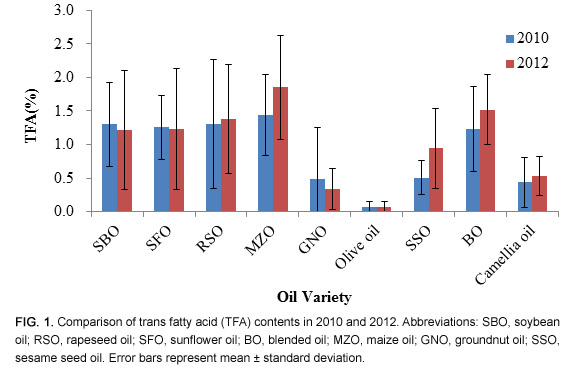
Both found that 90% of the samples contained TFA below 0.2%. Only two oil varieties had an obvious increase in TFA average contents: maize oil and sesameseed oil. The much larger sample size and the diverse qualities included in this survey could explain the increase. The intentional adding of blended oil to sesame oil and the possible inclusion of fraudulent oils could also explain such increases.
Several other studies related to TFA contents within Chinese food appeared in 2012 (Gao et al., 2012; Ning et al., 2012). Soybean oil constitutes the largest portion of vegetable oil consumption in China. Thus, it was chosen in these three papers as the basis for comparing the similarities of our results with those of other studies. Figure 2 shows that all of the surveys yielded similar outcomes, that is, a slight decrease of TFA content in soybean oil between 2010 and 2012.
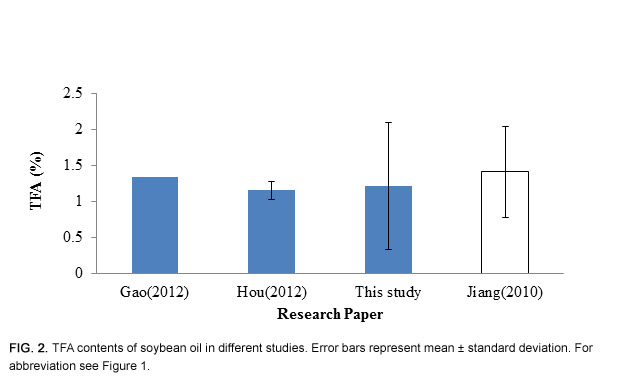
In general, TFA content within bottled cooking oils remained at roughly the same level as in 2010 (Jiang et al., 2010). Nearly 90% of samples contained less than 2% TFA. In addition, unrefined oils contained lower concentrations compared to refined oils.
Food service oil
This is the first research to date that has included food service oil. Seventy-four samples were collected from different areas in China, and five different varieties were measured. All five oil varieties contained quite low TFA concentrations (Fig. 3).
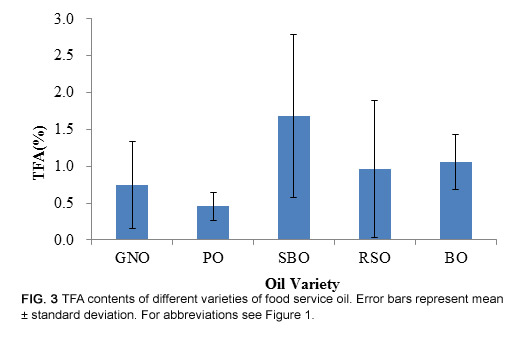
Palm oil possessed the lowest TFA, which might be caused by its higher saturated fatty acid content. TFA concentrations in food service oils were much lower than those in corresponding bottled cooking oil varieties. Note that restaurants and hotels in China care less about the color and appearance of the oil than consumers do, which leads to milder refining of food service oils. Reduced refining is believed to have a positive effect on TFA concentrations. In short, TFA concentrations in catering oils were much lower than those in corresponding bottled cooking oil categories, and they were lowest in palm oil.
Oil-bearing foods
Although Chinese consumed much less fried and baked food with higher oil content compared to westerners, the intake of such food has increased year by year. Consequently, oil-bearing foods are possibily the most important source of hydrogenated vegetable oil intake for Chinese and play an important role in the study of TFA intake. Two hundred fifty-seven samples from nine categories (cake, bread and pie; cookies; chips; ice cream; chocolate; popcorn; instant noodles; nondairy creamer; and whipped topping) were collected from supermarkets and bakery houses.
All samples contained less than 5% TFA (oil base), with the exception of two samples in the cookie category (Fig. 4), and only some samples in the cake, bread and pie, cookie, chocolate, and instant noodle category had TFA contents in the range of 2% to 5% (Table 1). TFA levels in popcorn, ice cream, nondairy creamer, fried chips, and whipping cream were less than 2% (oil base).
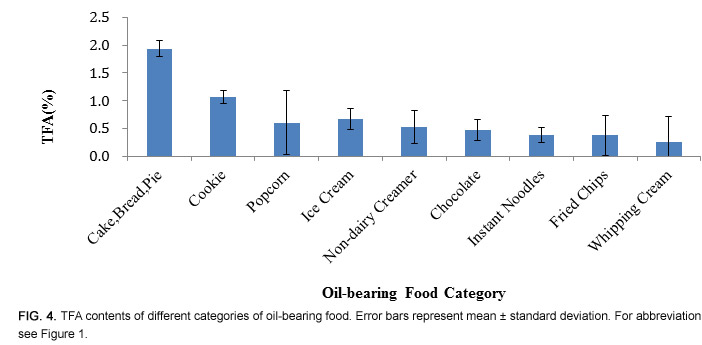
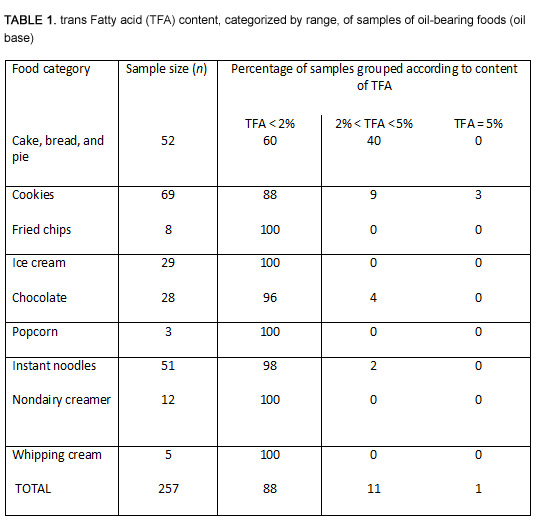
Almost all of the research published in the past four years on TFA in China confirms that cake, bread, and pie are the categories of food with the highest TFA concentrations (Fig. 5). Partially hydrogenated oil, which is the most popular component of coatings and fillings, could be the source of the higher TFA in these categories.
Figure 5 shows a reduction in TFA concentrations occurred in three of four categories from 2008 to 2012, although TFA concentrations varied depending on the food category. Table 2 compares the analytical results of five categories included by our survey and by that of Fu et al. (2008). The percentage of samples containing more than 2% TFA decreased by more than 50% from 2010 to 2012.
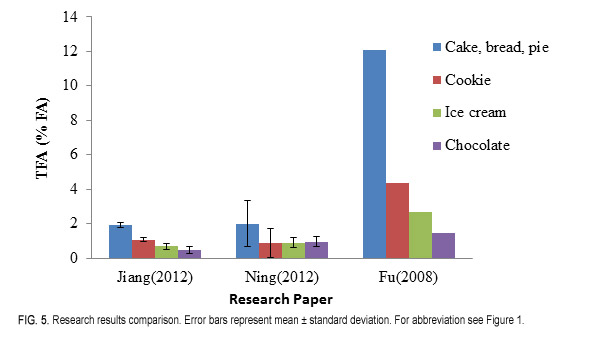
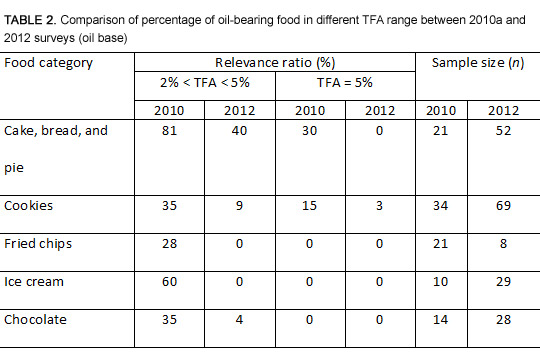
Conclusion
The outcomes of this survey, which were presented in August 2012 at the ICC/CCOA Cereal and Bread Congress entitled “Science and Technology Innovation for Healthy Cereals & Oils” held in Beijing, China, revealed that the TFA content within bottled cooking oils remained at the same level as those reported by Jiang et al. in 2010 (almost 90% had a TFA content less than 0.2%). Meanwhile, there was a significant reduction in the TFA concentration in oil-bearing processed foods, and the TFA amounts in catering oils were generally lower than bottled cooking oils. The results demonstrated that significant improvements were made in food and oils in China thanks to industrial efforts.
Yuanrong Jiang ,Ph.D.,has worked as R&D director in Wilmar International Ltd. since 2006. Her research interests involve nutrition and health of fatty acids, oxidative stability and antioxidants of fats and oil,s and their processing and flavor. The Chinese government has given her numerous scientific achievement awards. She has over 40 publications and has applied for 20 patents. She may be contacted at jiangyuanrong@wilmar-intl.com. The author thanks Xuebing Xu, Peng Hu, Yuquan Zhang, Shuhua Xia, and Jingyi Zhang for their assistance in collecting and organizing the data and preparing this paper.
information
1. Ascherio, A., M.B. Katan, P.L. Zock, M.J. Stamfer, and W.C. Willett, trans fatty acids and coronary heart disease, New Engl. J. Med. 340:1994–1998 (1999).
2. Fu, H., L. Yang, H. Yuan, P. Rao, and Y.M. Lo, Assessment of trans fatty acids content in popular western-style products in China, J. Food Sci. 79:383–391 (2008).
3. Fu, H., L. Zhao, L. Yang, D. Lai, et al., Survey of trans fatty acids in foods in Chinese market, J. Chin. Inst. Food Sci. Technol. 10(4):48–52 (2010).
4. Gao, H., J. Guo, Y. Li, Z. Feng, and B. Pei, Investigation on trans fatty acids in the primary edible vegetable oil in China, China Oils Fats 37(3):1–5 (2012).
5. GB/T 22110-2008, Determination of trans fatty acids in foods-gas chromatographic method.
6. Hou, J., F. Wang, Y. Wang, J. Xu, and C. Zhang, Assessment of trans fatty acids in edible oils in China, Food Control 25:211–215 (2012).
7. Jiang, Y., S. Xia, Y. Zhang, J Yu, and H. Yang, Present situation and production process control of trans fatty acid in edible oil, J. Chin. Inst. Food Sci. Technol. 10(4):53–59 (2010).
8. Ning, W., Y. Li, Y. Wang, W. Han, et al., The content of trans fatty acids in instant food in Yantai, Chin. J. Food Hyg. 24:74–76 (2012).
9. Niu, C., Determination of trans fatty acids in foods and assessment of dietary intake of adolescents, M.S. Thesis in Agriculture, Agricultural University of Hebei, June 2011.
10. Oh, K., F.B. Hu, J.E. Manson, M.J. Stampfer, and W.C. Willett, Dietary fat intake and risk of coronary heart disease in women: 20 years of follow-up of the nurses’ health study, Am. J. Epidemiol. 161:672–679 (2005).
11. Pietinen, P., A. Ascherio, P. Korhonen, A.M. Hartman, and W.C. Willett, Intake of fatty acids and risk of coronary heart disease in a cohort of Finnish men, Am. J. Epidemiol. 145:876–887 (1997).
